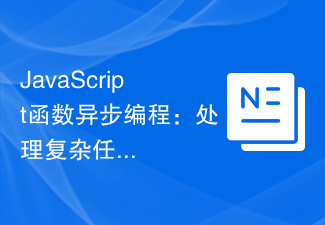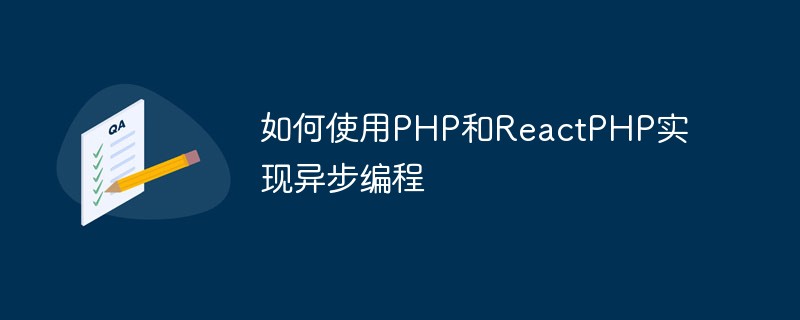异步编程和非阻塞 I/O 处理是两项针对 Go 函数性能优化的重要技术。异步编程通过使用 goroutine 实现并发执行 I/O 操作,而非阻塞 I/O 处理允许立即返回而不等待 I/O 完成,从而提高应用程序的吞吐量。通过使用这些技术,可以优化处理大量 HTTP 请求等实战案例,从而显着增强 Go 函数的性能。

Go 函数性能优化:异步编程与非阻塞I/O 处理
在开发高性能Go 应用程序时,优化函数性能至关重要。本文将探讨两种常见的 Go 性能优化技术:异步编程和非阻塞 I/O 处理。
异步编程
异步编程允许函数在等待 I/O 操作完成的同时继续执行。它可以显着减少阻塞时间,从而提高函数响应能力。
在 Go 中,使用 goroutine 可以实现异步编程。一个 goroutine 是一种并发函数,它与主函数在独立的线程中运行。以下是使用goroutine 执行异步I/O 操作的示例:
package main
import (
"context"
"fmt"
"io"
"net/http"
)
func main() {
// 创建一个 HTTP 客户端
client := &http.Client{}
// 创建一个 HTTP 请求
req, err := http.NewRequest("GET", "https://www.example.com", nil)
if err != nil {
// 处理错误
return
}
// 创建一个上下文,用于控制并发 goroutine
ctx := context.Background()
// 创建一个 goroutine 来处理 HTTP 请求
go func() {
resp, err := client.Do(req)
if err != nil {
// 处理错误
return
}
// 读取 HTTP 响应体
body, err := io.ReadAll(resp.Body)
if err != nil {
// 处理错误
return
}
// 处理 HTTP 响应体
fmt.Println(body)
}()
// 主函数可以在此时继续执行其他任务
// ...
}非阻塞I/O 处理
非阻塞I/O 处理允许函数立即返回,而不等待I/O 操作完成。这可以提高应用程序的吞吐量,因为它可以同时处理多个 I/O 请求。
在 Go 中,使用 io.Poll() 函数可以实现非阻塞 I/O 处理。 io.Poll() 函数监控一组文件描述符,当 I/O 操作可以进行时返回。以下是使用io.Poll() 执行非阻塞I/O 操作的示例:
package main
import (
"fmt"
"io"
"os"
"time"
)
func main() {
// 打开一个文件
file, err := os.OpenFile("test.txt", os.O_RDONLY, 0644)
if err != nil {
// 处理错误
return
}
defer file.Close()
// 创建一个文件描述符集
fds := []int{file.Fd()}
// 创建一个超时时间
timeout := 10 * time.Second
// 无限循环,直到超时或有 I/O 操作可以进行
for {
// 轮询文件描述符集
events, err := io.Poll(fds, timeout)
if err != nil {
// 处理错误
return
}
// 检查是否有文件描述符可读
if len(events) > 0 {
// 读取文件
buffer := make([]byte, 1024)
n, err := file.Read(buffer)
if err != nil {
// 处理错误
return
}
// 处理读取到的数据
fmt.Println(string(buffer[:n]))
}
}
}实战案例
下面是一个实战案例,展示如何使用异步编程和非阻塞I/O 处理优化处理大量HTTP 请求的函数:
package main
import (
"context"
"fmt"
"io"
"net/http"
"sync"
)
// 创建一个 goroutine 池
var pool = sync.Pool{
New: func() interface{} {
req, err := http.NewRequest("GET", "https://www.example.com", nil)
if err != nil {
return nil
}
return req
},
}
// 使用 goroutine 池来处理请求
func handleRequest(w http.ResponseWriter, r *http.Request) {
defer pool.Put(r) // 在返回后将请求放回池中
ctx := context.Background()
// 创建一个 HTTP 客户端
client := &http.Client{}
resp, err := client.Do(r)
if err != nil {
// 处理错误
return
}
// 读取 HTTP 响应体
body, err := io.ReadAll(resp.Body)
if err != nil {
// 处理错误
return
}
// 处理 HTTP 响应体
w.Write(body)
}
func main() {
// 创建一个 HTTP 服务器
http.HandleFunc("/", handleRequest)
http.ListenAndServe(":8080", nil)
}使用异步编程和非阻塞I/O 处理,此函数可以利用goroutine 池和非阻塞http.Client.Do () 方法来同时处理多个HTTP 请求,从而显着提高应用程序的吞吐量和响应能力。
以上是Go函数性能优化:异步编程与非阻塞IO处理的详细内容。更多信息请关注PHP中文网其他相关文章!
 JavaScript函数异步编程:处理复杂任务的必备技巧Nov 18, 2023 am 10:06 AM
JavaScript函数异步编程:处理复杂任务的必备技巧Nov 18, 2023 am 10:06 AMJavaScript函数异步编程:处理复杂任务的必备技巧引言:在现代前端开发中,处理复杂任务已经成为了必不可少的一部分。而JavaScript函数异步编程技巧则是解决这些复杂任务的关键。本文将介绍JavaScript函数异步编程的基本概念和常用的实践方法,并提供具体的代码示例,帮助读者更好地理解和使用这些技巧。一、异步编程的基本概念在传统的同步编程中,代码按
 PHP中如何使用ReactPHP进行异步编程Jun 27, 2023 am 09:14 AM
PHP中如何使用ReactPHP进行异步编程Jun 27, 2023 am 09:14 AM随着Web应用程序变得越来越复杂,程序员不得不采用异步编程来处理大量请求和I/O操作。PHP:HypertextPreprocessor也不例外。为了满足这一需求,ReactPHP已经成为目前最受欢迎的PHP异步编程框架之一。在本文中,将讨论如何在PHP中使用ReactPHP进行异步编程。1.ReactPHP简介ReactPHP是一个基于事件驱动编程
 如何在PHP中实现异步消息处理Jul 10, 2023 am 08:19 AM
如何在PHP中实现异步消息处理Jul 10, 2023 am 08:19 AM如何在PHP中实现异步消息处理引言:在现代的Web应用程序中,异步消息处理变得越来越重要。异步消息处理可以提高系统的性能和可扩展性,并改善用户体验。PHP作为一种常用的服务器端编程语言,也可以通过一些技术来实现异步消息处理。在本文中,我们将介绍一些PHP中实现异步消息处理的方法,并提供代码示例。使用消息队列消息队列是一种解耦系统组件的方式,它允许不同的组件在
 深入理解PHP8的新特性:如何高效使用异步编程和代码?Sep 11, 2023 pm 01:52 PM
深入理解PHP8的新特性:如何高效使用异步编程和代码?Sep 11, 2023 pm 01:52 PM深入理解PHP8的新特性:如何高效使用异步编程和代码?PHP8是PHP编程语言的最新主要版本,带来了许多令人兴奋的新特性和改进。其中最突出的特性之一是对异步编程的支持。异步编程允许我们在处理并发任务时提高性能和响应能力。本文将深入探讨PHP8的异步编程特性,并介绍如何高效地使用它们。首先,让我们了解一下什么是异步编程。在传统的同步编程模型中,代码按照线性的顺
 如何使用PHP和ReactPHP实现异步编程May 11, 2023 pm 02:00 PM
如何使用PHP和ReactPHP实现异步编程May 11, 2023 pm 02:00 PM随着互联网应用场景的不断发展,人们对Web应用的要求也越来越高。为了提高Web应用的性能和响应速度,异步编程已经成为现代Web应用开发不可或缺的一部分。PHP是一门广泛使用的Web开发语言,而ReactPHP则是一个基于PHP的异步编程框架。本篇文章将介绍如何使用PHP和ReactPHP实现异步编程。一、什么是异步编程?在编程中,同步和异步是两种常用的编程方
 前往Golang学习之Web服务端的异步编程模式Jun 24, 2023 am 10:52 AM
前往Golang学习之Web服务端的异步编程模式Jun 24, 2023 am 10:52 AM随着互联网技术的快速发展,Web服务端的开发成为了当前互联网行业的热门话题。而Golang作为一门新兴的编程语言,凭借其高效、并发的特性,也成为了Web服务端开发的首选语言之一。本文将会介绍GolangWeb服务端的异步编程模式,旨在帮助读者更好地掌握Golang在Web服务端开发中的应用。一、什么是异步编程模式异步编程模式是指程序的执行不是按照程序的顺序
 如何在Go语言中实现异步编程Jun 04, 2023 am 08:10 AM
如何在Go语言中实现异步编程Jun 04, 2023 am 08:10 AM随着互联网技术的不断发展,高并发高可用的需求越来越强烈。而异步编程是提高程序运行效率和响应能力的有效手段之一。Go语言作为一种新兴的编程语言,天生支持并发和异步编程,极大地方便了程序员的开发工作。本文将介绍如何在Go语言中实现异步编程。一、Go语言中的goroutineGo语言提供了goroutine机制,可以轻松地实现并发和异步操作。goroutine是一
 Spring Boot与Kotlin协程的整合和异步编程Jun 22, 2023 pm 06:22 PM
Spring Boot与Kotlin协程的整合和异步编程Jun 22, 2023 pm 06:22 PM随着现代Web应用的复杂性不断增加,尤其是在分布式系统和微服务等领域,异步编程已经成为了新的标配。SpringBoot是用于构建基于Spring框架的快速Web应用程序的工具,而Kotlin协程是一种基于协程的异步编程方式。在本文中,我们将讨论如何将它们整合起来,实现更高效的异步编程。Kotlin协程简介Kotlin语言是一种静态类型的编程语言,从1.3版


热AI工具

Undresser.AI Undress
人工智能驱动的应用程序,用于创建逼真的裸体照片

AI Clothes Remover
用于从照片中去除衣服的在线人工智能工具。

Undress AI Tool
免费脱衣服图片

Clothoff.io
AI脱衣机

AI Hentai Generator
免费生成ai无尽的。

热门文章

热工具

Dreamweaver CS6
视觉化网页开发工具

禅工作室 13.0.1
功能强大的PHP集成开发环境

适用于 Eclipse 的 SAP NetWeaver 服务器适配器
将Eclipse与SAP NetWeaver应用服务器集成。

mPDF
mPDF是一个PHP库,可以从UTF-8编码的HTML生成PDF文件。原作者Ian Back编写mPDF以从他的网站上“即时”输出PDF文件,并处理不同的语言。与原始脚本如HTML2FPDF相比,它的速度较慢,并且在使用Unicode字体时生成的文件较大,但支持CSS样式等,并进行了大量增强。支持几乎所有语言,包括RTL(阿拉伯语和希伯来语)和CJK(中日韩)。支持嵌套的块级元素(如P、DIV),

Atom编辑器mac版下载
最流行的的开源编辑器






